
NOAAS Oceanographer, originally USC&GS Oceanographer, was an American Oceanographer-class oceanographic research vessel in service in the United States Coast and Geodetic Survey from 1966 to 1970 and in the National Oceanic and Atmospheric Administration (NOAA) from 1970 to 1996. She served as flagship of both the Coast and Geodetic Survey and NOAA fleets.
The Naval Oceanographic Office (NAVOCEANO), located at John C. Stennis Space Center in south Mississippi, is an echelon IV component of the Naval Meteorology and Oceanography Command (NMOC) and comprises approximately 1,000 civilian, military and contract personnel responsible for providing oceanographic products and services to all elements within the Department of Defense.
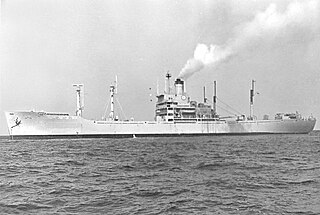
USNS Dutton (T-AGS-22) was an oceanographic survey ship for the United States Navy from the late 1950s through the 1980s. She was launched as SS Tuskegee Victory in 1945, Maritime Commission hull number MCV 682, a type VC2-S-AP3 Victory ship. In her U.S. Navy service, she was named after Captain Benjamin Dutton, Jr., and was the second U.S. Navy ship named in his honor.

A multibeam echosounder (MBES) is a type of sonar that is used to map the seabed. It emits acoustic waves in a fan shape beneath its transceiver. The time it takes for the sound waves to reflect off the seabed and return to the receiver is used to calculate the water depth. Unlike other sonars and echo sounders, MBES uses beamforming to extract directional information from the returning soundwaves, producing a swathe of depth soundings from a single ping.
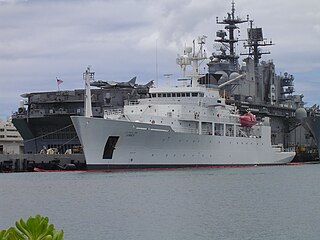
USNS Sumner (T-AGS-61) is a Pathfinder-class oceanographic survey ship that became operational in 1997. It is the fourth United States Navy ship named Sumner, in this case for Thomas Hubbard Sumner, an American sea captain who discovered the principles of celestial navigation by circle of equal altitude. These ships are crewed by a small crew of civilian mariners, supporting an even smaller contingent of United States Navy personnel.

The Pathfinder-class survey ships are owned by the United States Navy and operated by Military Sealift Command for the Naval Oceanographic Office ("NAVOCEANO"). They have mostly civilian crews, including scientists from NAVOCEANO.

USNS Titan (T-AGOS-15) was a Stalwart-class modified tactical auxiliary general ocean surveillance ship in service in the United States Navy from 1989 to 1993. From 1996 to 2014, she was in commission in the National Oceanic and Atmospheric Administration (NOAA) fleet as the oceanographic research ship NOAAS Ka'imimoana.

USNS Relentless (T-AGOS-18) was a Stalwart-class modified tactical auxiliary general ocean surveillance ship in service in the United States Navy from 1990 to 1993. Since 1998, she has been in commission in the National Oceanic and Atmospheric Administration (NOAA) fleet as the fisheries research ship NOAAS Gordon Gunter.

USNS Bowditch (T-AGS-21) was the lead ship of her class of oceanographic survey ships for the United States Navy. Launched as the SS South Bend Victory in 1945, Maritime Commission hull number MCV 694, a type VC2-S-AP3 Victory ship, she was named for Nathaniel Bowditch, the second U.S. Navy vessel named in his honor. The ship was acquired by the Navy in August 1957 and converted to an AGS at Charleston Naval Shipyard. Named Bowditch on 8 August 1957 and placed in service 8 October 1958 for operation by the Military Sea Transportation Service (MSTS).

NOAAS Thomas Jefferson is a National Oceanic and Atmospheric Administration (NOAA) hydrographic survey vessel in service since 2003. The ship was built for the United States Navy as USNS Littlehales (T-AGS-52) serving as one of two new coastal hydrographic survey vessels from 1992 until transfer to NOAA in 2003 when it was named after Founding Father and third U.S. president, Thomas Jefferson.

TS State of Maine is the current training ship of the Maine Maritime Academy. Formerly in United States Navy service as the USNS Tanner (T-AGS-40), she assumed her present name and role in June 1997.
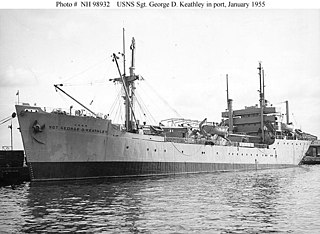
USNS Sgt. George D. Keathley, was a World War II United States cargo vessel that was used for troop transport and later converted to a survey vessel. She was laid down and launched as MS Alexander R. Nininger, Jr., then renamed MS Acorn Knot. She was put into US Army service as USAT Acorn Knot, then renamed USAT Sgt. George D. Keathley. She was transferred to the US Navy and became USNS Sgt. George D. Keathley (T-APC-117), but was later re-designated T-AGS-35. She was leased to the Republic of China, where she served as Chu Hwa (AGS-564). Both Nininger and Keathley were posthumous Medal of Honor recipients.

USNS James M. Gilliss (T-AGOR-4) was a Robert D. Conrad-class oceanographic research ship acquired by the U.S. Navy in 1962. The ship was operated by the Military Sea Transportation Service and managed by the Naval Oceanographic Office as one of the "Navy Pool" vessels serving various Navy laboratories and projects in the Atlantic Ocean. After active Navy pool service the ship was assigned to the University of Miami to operate as part of the University-National Oceanographic Laboratory System (UNOLS) fleet until 1979.

USNS Eltanin (T-AK-270/T-AGOR-8) was an Eltanin-class cargo ship with an ice-breaking hull acquired by the U.S. Navy in 1957 and then operated by the Navy in a non-commissioned status, named after Eltanin, a star in the constellation Draco. Her designation was changed to that of an oceanographic research ship in 1962 when she operated in Antarctic waters.
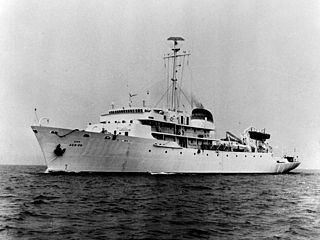
USNS Silas Bent (T-AGS-26) was a Silas Bent class survey ship acquired by the United States Navy in 1964 and delivered to the Military Sealift Command in 1965. Silas Bent spent her career in the Pacific Ocean performing oceanographic surveys. The ship was equipped with the Oceanographic Data Acquisition System (ODAS) as were the later oceanographic survey ships USNS Kane (T-AGS-27) and USNS Wilkes (T-AGS-33).

NOAAS Discoverer, originally USC&GS Discoverer, was an American Oceanographer-class oceanographic research vessel in service in the United States Coast and Geodetic Survey from 1966 to 1970 and in the National Oceanic and Atmospheric Administration (NOAA) from 1970 to 1996.
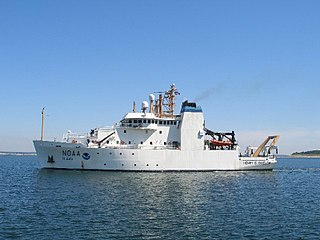
NOAAS Henry B. Bigelow is a fisheries research vessel operated by the United States' National Oceanic Atmospheric Administration (NOAA). She is the second in a class of five fisheries research vessels. She is named after Henry Bryant Bigelow (1879-1967), the American oceanographer, zoologist, and marine biologist who founded the Woods Hole Oceanographic Institution in Woods Hole, Massachusetts.

USNS Marie Tharp (T-AGS-66) is a Pathfinder-class oceanographic survey ship operated by the Military Sealift Command of the United States Navy. The seventh ship in her class, Marie Tharp is named for oceanographer Marie Tharp; the ship was renamed in 2023 from Maury.

USNS John McDonnell (T-AGS-51) was a hydrographic survey ship operated by the Military Sealift Command (MSC) with a contract crew for the Naval Oceanographic Office which assigned a military and civilian hydrographic detachment to conduct coastal surveys. The ship and its sister, USNS Littlehales (T-AGS-52), were replacements for the coastal hydrographic survey vessels USNS Chauvenet (T-AGS-29) and USNS Harkness (T-AGS-32).

USNS Chauvenet (T-AGS-29) was a multi-function survey ship laid down on 24 May 1967, at Upper Clyde Shipbuilding Corp., Glasgow, Scotland. The ship was the second survey ship, Chauvenet (AGS-11) being the first, named for William Chauvenet (1820-1870). He was instrumental in the founding of the United States Naval Academy at Annapolis, MD. The mathematics department of the US Naval Academy in Annapolis was founded by Chauvenet and is housed in Chauvenet Hall. Chauvenet was launched on 13 May 1968, delivered to the US Navy, 13 November 1970 and placed in service with the Military Sealift Command (MSC) as USNS Chauvenet (T-AGS-29). The ship conducted coastal hydrographic and topographic surveys under the technical direction of the Oceanographer of the Navy through the U.S. Naval Oceanographic Office (NAVOCEANO). The ship was assigned to the Pacific for surveys, sister ship Harkness (T-AGS-32) was assigned Atlantic duties, doing so until inactivated in November 1992.





















